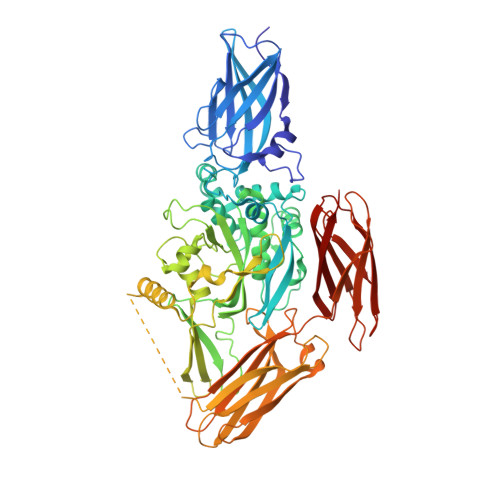Three-dimensional structure of the human transglutaminase 3 enzyme: binding of calcium ions changes structure for activation.
Ahvazi, B., Kim, H.C., Kee, S.H., Nemes, Z., Steinert, P.M.(2002) EMBO J 21: 2055-2067
- PubMed: 11980702
- DOI: https://doi.org/10.1093/emboj/21.9.2055
- Primary Citation of Related Structures:
1L9M, 1L9N - PubMed Abstract:
Transglutaminase (TGase) enzymes catalyze the formation of covalent cross-links between protein-bound glutamines and lysines in a calcium-dependent manner, but the role of Ca(2+) ions remains unclear. The TGase 3 isoform is widely expressed and is important for epithelial barrier formation. It is a zymogen, requiring proteolysis for activity. We have solved the three-dimensional structures of the zymogen and the activated forms at 2.2 and 2.1 A resolution, respectively, and examined the role of Ca(2+) ions. The zymogen binds one ion tightly that cannot be exchanged. Upon proteolysis, the enzyme exothermally acquires two more Ca(2+) ions that activate the enzyme, are exchangeable and are functionally replaceable by other lanthanide trivalent cations. Binding of a Ca(2+) ion at one of these sites opens a channel which exposes the key Trp236 and Trp327 residues that control substrate access to the active site. Together, these biochemical and structural data reveal for the first time in a TGase enzyme that Ca(2+) ions induce structural changes which at least in part dictate activity and, moreover, may confer substrate specificity.
Organizational Affiliation:
Laboratory of Skin Biology, National Institute of Arthritis and Musculoskeletal and Skin Diseases, National Institutes of Health, Bethesda, MD 20892-8023, USA. Bijan@discus.niams.nih.gov

















